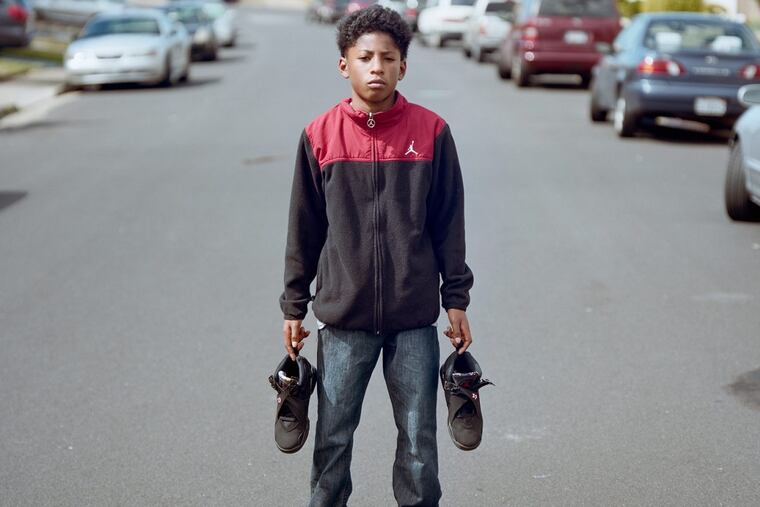To this artist, the legacy of Air Jordans isn't all it's cracked up to be | Elizabeth Wellington
The Philadelphia Photo Arts Center exhibit "Nobody" is not what you would expect from a show billed as a pictorial take on Nike's Air Jordans. Instead, it's a rather maudlin statement of the impact of the Nike shoe obsession on inner-city kids.

In this era of Instagrammable street fashion, sneaker culture is sexy. It's glossy. It's aspirational.
You can't be a Hypebeast or a Hypebae without a tight shoe game. But there's a dark side to having a kicks festish.
That dark side is the subject of Bay Area artist Mark Jayson Quines' chilling photography exhibit "Nobody" on display at the Philadelphia Photo Arts Center through Feb. 17. Quines' work was one of two winners of the center's annual contemporary photography competition.
"Nobody" is not what I expected from a show billed as a pictorial take on Nike's Air Jordan. Instead, it's a maudlin statement on the impact the Nike obsession has on people in the inner city, spending money they don't have or reaching for an empty status symbol.
In addition to the photographs, Quines included found objects in the collection: dirty deflated basketballs, a broken scoreboard, and a copy of the 1960s Nigerian paperback Money is Hard to Get But Easy to Spend.
Talk about a clear message.
"My intention with this work was for me to understand what Jordans and sneaker culture means to me," Quines said. "My biggest takeaway here is self-worth."
Air Jordans, named after the incomparable Michael Jordan, made their debut in November 1984. I was 11 and remember my mother saying, "Who in the world would pay that much money for a sneaker?" (Back then, they were $65. Now, some pairs cost upward of $500 and have inspired a rabid fanbase.)
But Quines, 29, can't remember a time when the tennis shoe wasn't at the forefront of pop culture and fashion. As a child, he watched his godfather clean his Jordans meticulously. By the time Quines was in middle school, he'd developed an infatuation with the shoe.
It was around that time that Quines discovered he wanted to be a photographer. When he wasn't checking for the latest sneaker, he was shooting punk concerts and scenes of everyday life in his hometown of Daly City, a melting pot of Latinos, African Americans, and Asians outside San Francisco. Air Jordans and all things Nike dominated his photos.
"It wasn't like I woke up one day and said, 'I'm going to specifically shoot Jordans,' " said Quines, who is Filipino. "I was just shooting a lot of things for myself … and I just kept coming back to them."
Quines is aware of the weight of his project. That is why he's careful about labeling the people in his photographs. He is also conscious of cultural appropriation. Most of the subjects in his exhibit are black, save for a Latino couple. Still, he doesn't see his subjects as "others" because, he says, he's a part of the culture, as well. After all, a lot of Quines' pop culture references were shaped by hip-hop. And I believe him. He titled "Nobody" after R&B crooner Keith Sweat's 1996 song.
"Who can love you like me? Nobody. Who can give you what you need? Nobody?" Quines said as he sang the hook of Sweat's hit. "And I thought to myself, 'That's Jordan. Nobody is like him.' … At the same time, he said there is a double meaning, like the old saying, 'When you don't have money, you will be considered Mr. Nobody.' "
Again, Quines points out, he's not wagging his finger in judgment or bashing sneaker culture.
"There was a period in my life where I was like, 'Boy, I'm spending all this money on these shoes and I just don't have it,' " Quines said. "So I sold them. I sold all of them."
The reality, though, is that these images are harsh. A theme of the show, Quines said, revolves around being lost and alone. No matter how dope your shoes are, the status symbol sometimes just isn't enough.
In all of the photos, the young men are by themselves: a teenager wearing a Jordan athletic jacket with a pair of black Jordans slung around his neck, a grown man photographed from the waist down wearing a pair of cobalt and black high-top Jordans with cash dangling from his hands.
The only hint of affluence in this show is in the tiny photos of Michael Jordan's home. One picture is titled "Fan's View," cut into topiary of the 23, Jordan's retired Chicago Bulls number. The other is "Jordan's View," the athlete's heavenly view of his greenery.
"It's very telling," Quines said of Jordan's connection to the culture his brand created in the inner city. "He's removed from it all."